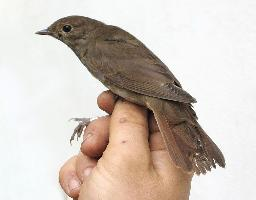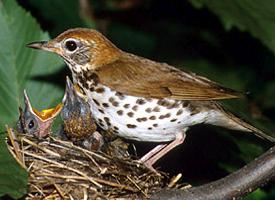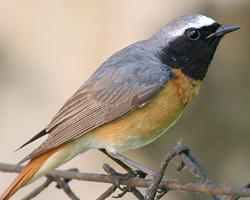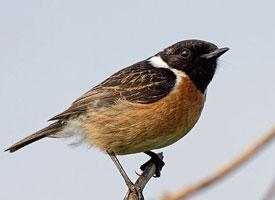
Poids et mesures
| Longueur | de 15 à 17 cm |
|---|---|
| Envergure des ailes | de 23 à 26 cm |
Description de l'animal
The Thrush Nightingale (Luscinia luscinia), also known as the Sprosser, is a small passerine bird that belongs to the Muscicapidae family, which encompasses a wide variety of Old World flycatchers. This bird species is celebrated for its rich, melodious song, a characteristic that it shares with its close relative, the more widely known Common Nightingale (Luscinia megarhynchos). Despite their similarities, the Thrush Nightingale can be distinguished by subtle differences in appearance and habitat preferences, as well as its unique vocalizations.Physical Description:
The Thrush Nightingale is a compact bird, measuring about 16-17 centimeters in length and weighing approximately 20-25 grams. It exhibits a rather plain appearance, with a predominantly brown upper body that seamlessly transitions into a lighter, more buff-colored underbelly. The bird's throat and chest may have a slightly reddish hue, particularly in males. One of its distinctive features is its large, dark eyes, which stand out against its relatively drab plumage, giving it an alert and watchful expression. Its legs are of a pale pink to brown color, and it possesses a strong, straight bill, which is ideal for foraging on insects and other small invertebrates.
Habitat and Distribution:
The Thrush Nightingale breeds in the dense, deciduous forests of northern and eastern Europe, extending into western Asia. Its preferred habitats are characterized by thick underbrush or the dense growth along riverbanks and wetlands, where it can find ample cover and food. The species is migratory, wintering in sub-Saharan Africa, where it occupies similar dense habitats, though it tends to avoid arid regions.
Behavior and Diet:
This species is primarily nocturnal, especially noted for its song during the breeding season, which can be heard both day and night. The male Thrush Nightingale's song is a loud, varied sequence of whistles, trills, and gurgles, performed to attract a mate and to establish territory. During the day, the bird is more reclusive, spending much of its time foraging on the forest floor, hidden among the underbrush. Its diet consists mainly of insects, including beetles, flies, and caterpillars, as well as spiders, worms, and occasionally berries and other small fruits.
Reproduction:
The breeding season for the Thrush Nightingale begins in late spring, when males arrive at the breeding grounds to establish territories and begin their nocturnal serenades. Once a female is attracted, the pair will build a nest hidden in dense vegetation, close to the ground. The female lays 4-6 eggs, which she incubates for about two weeks. After hatching, both parents are involved in feeding the chicks, which fledge approximately two weeks later. The young birds will then begin their journey to the wintering grounds in Africa, navigating thousands of kilometers across unfamiliar terrain.
Conservation Status:
The Thrush Nightingale is currently listed as Least Concern by the International Union for Conservation of Nature (IUCN), indicating that it is not at immediate risk of widespread decline. However, like many migratory bird species, it faces threats from habitat loss and degradation, both in its breeding and wintering grounds, as well as along its migratory routes. Conservation efforts aimed at preserving its natural habitats and mitigating other threats are essential to ensure the continued survival of this melodious bird species.
In summary, the Thrush Nightingale is a remarkable bird, not only for its beautiful song but also for its extensive migratory journey and adaptability to different habitats. Its presence enriches the biodiversity of the regions it inhabits, making it a species of interest not only to ornithologists but to all who appreciate the natural world.
Animaux similaires
Nouvelles photos d'animaux
Top 10 des animaux
- Dolphin gull (Leucophaeus scoresbii)
- Diana monkey (Cercopithecus diana)
- Moustached guenon (Cercopithecus cephus)
- Galápagos tortoise (Geochelone nigra complex)
- Japanese macaque (Macaca fuscata)
- Stone loach (Barbatula barbatula)
- Russian tortoise (Testudo horsfieldii)
- Greek tortoise (Testudo graeca)
- Common flying dragon (Draco volans)
- Vendace (Coregonus albula)


